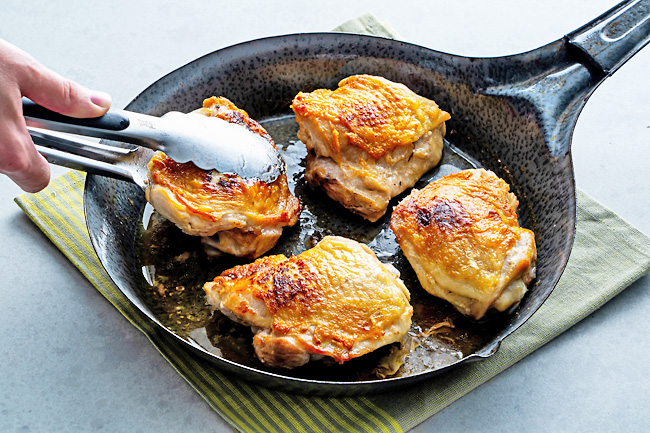THE WASHINGTON POST – Aaron Hutcherson (AH) and Becky Krystal (BK) answer questions and provide practical cooking advice in a chat with readers.
AH and BK write and test recipes for Voraciously, The Washington Post’s team dedicated to helping you cook with confidence.
Here are edited excerpts from a recent chat.
Q: A recurring problem arose yesterday when making air-fryer chicken legs. Using an instant-read thermometer deep in the thickest part, but being careful not to press the tip against bone, I cooked the chicken to 170 degrees, “just to be sure”. Yet it was still underdone near the bone. A quick zap in the microwave fixed it, but until cut open, I don’t know if it needs it or not. And yes, I have qualified the thermometer.
A: My main piece of advice is to take chicken (any animal protein for that matter) out of the refrigerator for 15 to 30 minutes before cooking. This should help it cook more evenly. – AH.
A: Also, dark meat can go higher – the higher temperatures actually break down the collagen, so things are especially tender and succulent. – BK.

Q: When boiling dried (presoaked) beans, a number of the beans will float to the surface. Are these considered bad and should therefore be skimmed off and thrown away?
A: Those beans are fine to eat. And side note: You don’t need to soak your beans! Bean guru and food editor Joe Yonan said that the flavour is actually best if you don’t soak them, but soaking can reduce the cooking time and flatulence. – AH.
Q: Whenever I make salsa using my food processor, the product is too watery. I’ve tried draining it, but that doesn’t help much.
A: I suspect part of the problem is the salsa is being overworked and broken down too much. It’s easy to overdo anything in a food processor. I take it you’re pulsing and not pureeing? Either way, maybe try to just pulse and pulse minimally. Sometimes actually putting less in the bowl can help prevent overworking the ingredients, because you’re not trying to get a tonne of items evenly chopped. Pulse and work in smaller batches, in other words. – BK.
Q: Many recipes, both for cooking and baking, call for coconut oil/milk/sugar, but I dislike the taste of coconut. Are there good substitutions?
A: I assume you’re specifically talking about nondairy/vegan recipes? I don’t think coconut sugar really tastes that much like coconut. When it comes to non-dairy milks, “If a recipe calls for a particular type of plant-based milk, use it if possible,” BK wrote in a recent piece on the subject. “The consensus, however, of everyone I talked to was that plant-based options are largely interchangeable.” For cooking with coconut oil, simply use another fat. When it comes to baking, I’d advise you to look for recipes specifically designed to work with other vegan fats. – AH.
Q: When using a handheld mixer, when do you use the fine-wire attachments or the thicker ones?
A: I only use the fine-wire, whisk-like attachment when whipping things, such as egg whites or heavy cream. I use the thicker beaters for everything else. – AH.
Q: So many great recipes call or lemon or lime juice and/or zest. If I keep those fruits around until I decide to make a recipe, they often rot or mummify; then when I’m really craving the recipe I don’t have the juice on hand to make it! Can I zest/juice a bag of citrus and store the juice/zest in the fridge? If so, in what type of container and for how long?
A: Yes! For the juice, I’d put it in ice cube trays, so they’re in one-tablespoon portions. Freeze, and then you can pop out and store in a bag or container. Zest I would just do in a small container or bag. I’d maybe use the zest sooner rather than later – maybe a month or so? – but I suspect the juice is fine for longer than that. – BK.
Q: I was gifted stainless steel pans recently and I have figured out how to prepare a variety of dishes without having the food stick to the pan. However, I have yet to master frying eggs without having them stick to the pan. I preheat the pan, do a test with a drop of water to verify it beads up (the pan is at the correct temp), then apply a small amount of oil over the surface (I’m currently using avocado oil), then crack the eggs into the pan. And still, they stick every time.
A: I feel you. Eggs are hard without a well-seasoned or nonstick pan. To me, the red flag here is “small amount” of oil. I have found that with food that are prone to sticking that you really don’t want to stick in a stainless pan, you need to be more generous with the oil. Like way more. – BK.
Q: I visited my sister and she made homemade doughnuts! They were delicious. She used olive oil for the frying fat. I thought the flavour came through a little bit in the donuts. What oil would you recommend, if I try this myself?
A: If you want a neutral flavour, vegetable oil is a good option for frying. – AH.
A: If you don’t have allergies, peanut oil is another good one for frying. – BK.







